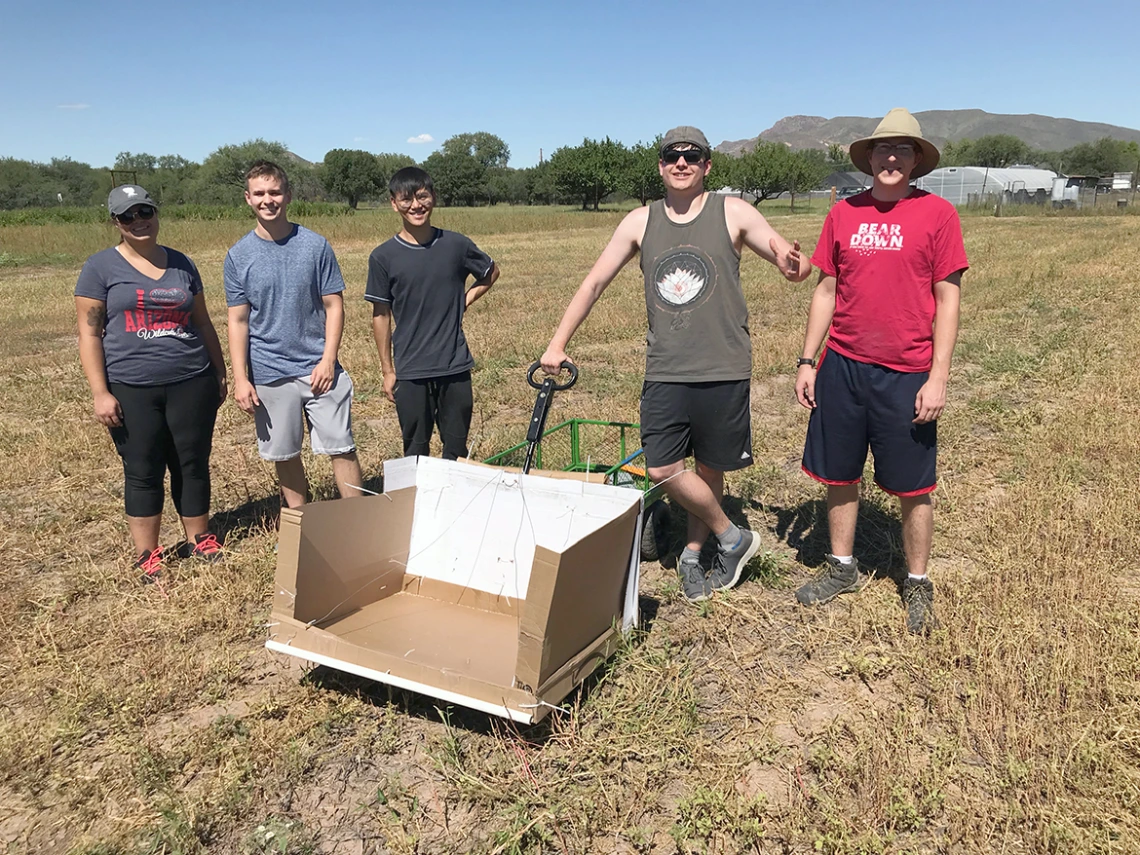Engineering Meets Agriculture

From left to right: Savannah Brown, Cooper Wynn, Weicheng Li, Sean Rowlands and Devin Murphy stand around their design for a grasshopper harvester, which they created with the help of fellow Engineering Design Program student Hannah Whetzel and professor Goggy Davidowitz

Project Title: Grasshopper Harvester
Team 18025 Members:
Savannah Marie Brown, biosystems engineering
Weicheng Li, mechanical engineering
Devin Patrick Murphy, biomedical engineering
Sean Rowlands, mechanical engineering
Hannah Grace Whetzel, mechanical engineering
Cooper Austin Wynn, electrical and computer engineering
Sponsor: UA Department of Entomology
Project Title: Robotic Weeding Machine for Leaf Lettuce Crops
Team 18029 Members:
Mark Jendrisak, biosystems engineering and mechanical engineering
Eunmo Kang, optical sciences and engineering
Connor John McCoy, biosystems engineering
Jesus Rene Nevarez, electrical and computer engineering
Tristan Stevens, biosystems engineering
Damian Willer, mechanical engineering
Sponsor: UA Department of Biosystems Engineering
Two UA faculty members are sponsoring senior design projects that lie at the intersection of engineering expertise and agricultural applications.
Grab That Grasshopper!
Goggy Davidowitz, professor of entomology at the University of Arizona, has a vested interest in grasshoppers. In the long term, he’d like to convince ranchers to raise grasshoppers instead of cows, and to see the insects — which are 12 times more efficient at converting grass to energy than cows — become a common source of protein for humans.
For the time being, however, farmers regard grasshoppers simply as pests that eat their crops. Davidowitz views harvesting the grasshoppers as a win because it eliminates the need for farmers to use unhealthy insecticides. His engineering design team is creating a machine that can capture grasshoppers in an agricultural field.
“Different species of grasshoppers jump differently,” Davidowitz said. “That means that from day to day, how high and far they jump will vary. How do you address that from an engineering perspective?”
He turned to the Engineering Design Program, hoping his team could use their talents to come up with a creative solution. So far, he’s taken the students to a local farmer’s grasshopper-infested field to test out some preliminary designs, given them a primer on grasshopper biology, and been altogether impressed with their enthusiasm and work ethic.
“I’m absolutely coming back to the program next year — that is a given,” he said. “On top of that, I have two other projects that I’m going to try to convince students to join.”
Weed Whacking, Not Lettuce Whacking
In the vegetable industry, workers remove the weeds around lettuce leaves, or spray them with herbicides, by hand. However, the lettuce industry is currently facing a shortage of workers, and hand labor in Arizona and California — where most of the country’s lettuce is grown — can be expensive.
Mark Siemens, associate professor of agricultural and biosystems engineering, is asking an engineering design team to build a robotic weeding machine for leaf lettuce crops. The machine will include a camera and a software system that allows farmers to monitor the device remotely.
“The students are going to develop a user interface with a touch screen and a camera, so you’ll get an image of a tray of weeds and crop plants, and you can select the weeds by hand. Then the machine will target the locations you select,” he said.
Eventually, Siemens would like to develop a version of this device that uses artificial intelligence to identify and kill weeds, but this group of students is focusing on the weed-killing aspect of the project, which is no small task.
“The challenge here is not only to not injure the crop plant and control the weeds, but to do so at a work rate that’s commercially viable,” Siemens said.
He jokes that he gave his students “pretty much an impossible problem” because researchers have been working on the question of how to kill weeds without harming plants for decades.
“I haven’t been able to crack the puzzle, so part of my motivation for doing a senior design project was to get some fresh thoughts on how to build such a machine,” he said. “The senior design program is an excellent opportunity for someone with a limited budget to make some progress on a project of interest.”

